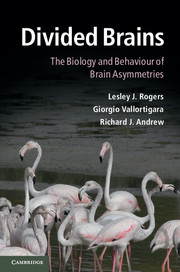3 - Evolution
Published online by Cambridge University Press: 05 February 2013
Summary
Summary
This chapter discusses the evolution of lateralization in vertebrates and their ancestors. Vertebrate asymmetry was dominated from the start by extraordinary bodily asymmetry, which determined the course of evolution of nervous system asymmetries. Modern Echinoderms (starfish and sea urchins) and all chordates (the group to which vertebrates belong) came from an ancestor that had extreme right–left asymmetry. Evidence from invertebrates, discussed later in this chapter, suggests that the possession of paired sense organs (including sensory inputs from paired appendages, as well as from paired eyes) has sometimes been sufficient to allow the evolution of lateralization of functions of the central nervous system. The evidence takes us far from the earlier notion that hemispheric specialization evolved in humans about 2.5 million years ago along with language, handedness and tool using. Although important steps in human evolution, discussed here, involved brain lateralization, they were shaped by pre-existing asymmetries, rather than appearing de novo.
Origins of asymmetry in chordates
Ancestral chordates lived in a marine environment (in the Cambrian/Precambrian periods) very different from any present today. Food was available as tiny algae near the surface of the sea and as organic remains that had sunk to the sea floor; both were exploited by animals. The rarity of deep burrowing forms of life (Bambach et al., 2007) meant that accumulation of edible particles in the deposits on the sea floor was greater than now. The structure of food webs (‘what ate what’) reveals that, because efficient predators were relatively scarce (albeit not non-existent, as shown by the recent discovery of a Cambrian, arthropod predator; Paterson et al., 2011), many organisms did well at this time without the need for very effective defences against predators or the ability to flee (Bambach et al., 2007).
- Type
- Chapter
- Information
- Divided BrainsThe Biology and Behaviour of Brain Asymmetries, pp. 62 - 97Publisher: Cambridge University PressPrint publication year: 2013
- 3
- Cited by

